Ravenscourt Park Hospital
Ravenscourt Park, W6 0TN
Medical dates:
Medical character:
Specialist
By the mid 1920s, the facilities at the Freemasons Hospital and Nursing Home had become inadequate. With only 59 beds and a usual waiting list of 40 patients, it was decided the building needed to be extended. Instead, however, in 1931 plans were made to build a new hospital with 180 beds at a new site in Ravenscourt Park.
A Nurses' Home and a boiler house were added in 1936.
The Hospital was exempted from joining the NHS in 1948 and continued as an independent hospital.
By the late 1970s, with more modern private hospitals opening in London, the Royal Masonic Hospital had severe financial difficulties. Bed occupancy was low and in 1978 non-Masons were accepted for treatment as private patients in a bid to improve the financial situation.
In 1984 an American health care company attempted to buy the Hospital for £20m, but was unsuccessful.
The Grand Lodge was embarrassed by the constant adverse publicity over the Hospital's finances and, in 1986, backed by some of the highest-ranking Masons, members of the management committee attempted to sell the building. This caused great outrage amongst the rank-and-file Masonic membership and a High Court writ was issued to stop the sale. The High Court ordered that all those who had contributed financially to the Hospital should be balloted.
Opposition to the sale prevailed and the Grand Lodge was forced to admit defeat.
The financial problems, however, did not go away and by 1988/9 annual losses had reached about £2m. A report was commissioned by the Duke of Kent, who was president of the Hospital, from the management consultants, Touche Ross.
The report (published in 1990 and which had cost £100,000) concluded that the Royal Masonic Hospital in order to survive would have to abandon its Masonic connections and undertake private work only. It also stated that the Hospital would need £9.7m over the next three years.
The Grand Lodge, who could have provided the funds from the Masons' Grand Charity, asked as a condition that the Hospital accept a new constitution, which would have allowed the Duke to appoint a Chairman and four members of the Board. The Hospital Board rejected this proposal.
The Duke of Kent almost immediately resigned as President and Prince Michael of Kent, the Provincial Grand-Master for Middlesex, resigned as Vice-President. The Hospital continued to be racked by controversies - its Finance Director was found to be an undisclosed bankrupt, various members of the senior management were dismissed for alleged misdemeanours and the staff pension fund was found to be "millions of pounds adrift". A group of governors fought to keep the Hospital going during all this turmoil, but eventually the Charity Commissioners called in the accountants Coopers and Lybrand to act as receiver and to sort out the financial problems. The firm recommended closure.
At a mass meeting in December 1994, Masons voted to close the Hospital and to dissolve the charity that ran it. The building and its Nurses Home in 8.5 acres of private gardens were put on the market for £15m.
It reopened as a private hospital - the Stamford Hospital.
In 2002 the Hospital was leased to the NHS as one of the first Diagnostic and Treatment Centres (DTC) - a government initiative to cut waiting lists for orthopaedic operations. It was renamed the Ravenscourt Park Hospital, the Stamford Hospital staff transferring to the NHS payroll.
It did help to cut waiting lists by two-thirds, but the 106 bed Hospital was underused and usually only half full - the backlog of waiting patients having been cleared, the scheme was a victim of its own success. In 2006 the Hammersmith Hospitals NHS Trust, having spent £8m in its refurbishment, sublet it (until 2017) to the London International Hospitals Group. NHS services were transferred to the nearby Charing Cross Hospital, along with most of the 200 members of staff.
Present status (July 2008)
The Grade II* listed Art Deco building, which has been vacant since 2006, is restricted by covenant to healthcare services. London International Hospitals plan to develop a five-star private hospital investing £100m in refurbishment and new equipment.
The Grade II listed Nurses' Home closed in 1994 and became a hostel for backpackers. It has now been redeveloped into an apartment block - Ashlar Court.
The Wakefield Centre in Ravenscourt Gardens is a nursing home for the elderly, with 102 beds. It opened in 1998.
Update: May 2012
The hospital buildings have been undergoing refurbishment but had been cleared of asbestos by 2010. The site does not appear to be active as a hospital currently but is being redeveloped as the London International Hospital. An acute private hospital, it will specialise in cancer and diseases of the heart and brain.
The Grade II* listed Art Deco building, which has been vacant since 2006, is restricted by covenant to healthcare services. London International Hospitals plan to develop a five-star private hospital investing £100m in refurbishment and new equipment.
The Grade II listed Nurses' Home closed in 1994 and became a hostel for backpackers. It has now been redeveloped into an apartment block - Ashlar Court.
The Wakefield Centre in Ravenscourt Gardens is a nursing home for the elderly, with 102 beds. It opened in 1998.
Update: May 2012
The hospital buildings have been undergoing refurbishment but had been cleared of asbestos by 2010. The site does not appear to be active as a hospital currently but is being redeveloped as the London International Hospital. An acute private hospital, it will specialise in cancer and diseases of the heart and brain.

The front elevation showing the two pylons flanking the main doorway (December 2007).
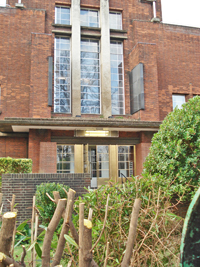
The main entrance (December 2007).
N.B. Photographs obtained in July 2008
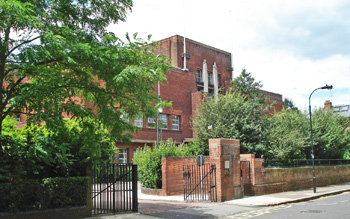
Main entrance driveway to the Hospital (above and below).
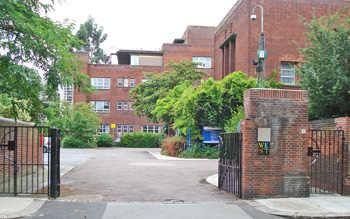
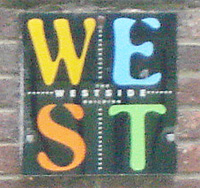
The entrance drive to the Hospital has signage on the gatepost to the Westside Building, an apartment block to the left of the driveway.
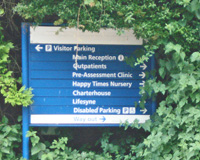
Old NHS-style blue signage still remains in July 2008.
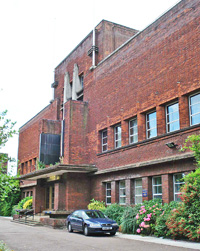
The Hospital building as seen from the north.
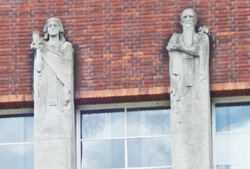
The statues of Healing and Charity at the tops of the pylons.
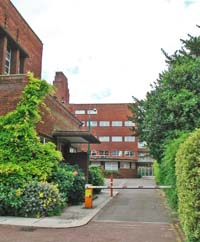
The northern elevation of the main Hospital building is seen on the left of the driveway, and further buildings ahead.
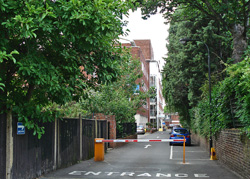
Driveway to the Wakefield Centre.
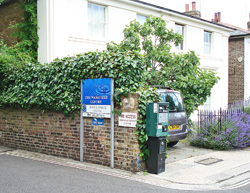
Signage to the Wakefield Centre, West London Clinic, in Ravenscourt Square.

Ravenscourt Gardens, connecting the Hospital building to the Nurses' Home, has lavender hedges.
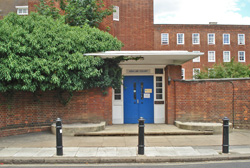
The entrance to the former Nurses' Home (July 2008).
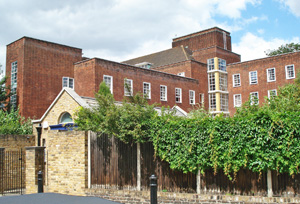
The east wing of the Nurses' Home (above and below).
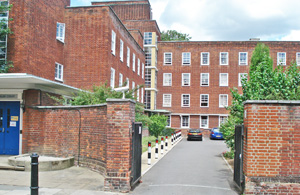
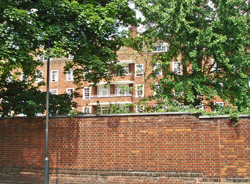
The Nurses Home became a hostel for backpackers.
NB Photos obtained in May 2012
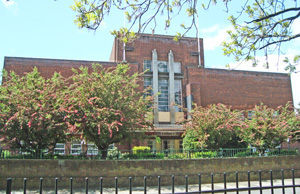
The Hospital looks much unchanged.
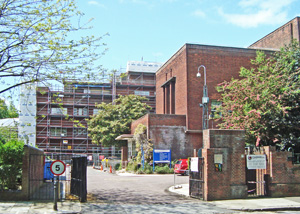
However, construction work is going on behind the main building (above and below).
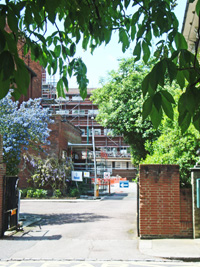
NB Photos obtained in April 2014
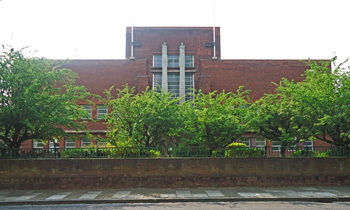
The former Hospital (above and below).
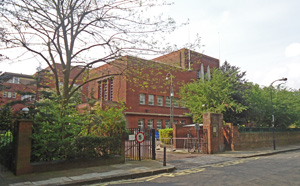
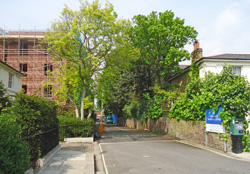
The Wakefield Centre has become the Chiswick Nursing Centre.
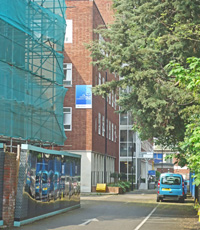
The Chiswick Nursing Centre
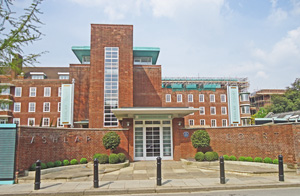
The former Nurses Home is now Ashlar Court, an apartment block redeveloped by Linden Homes (above and below).
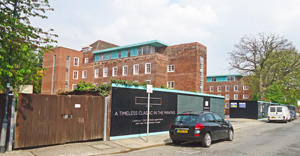
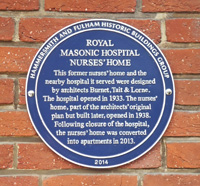
A blue plaque commemorates the building as a former Nurses' Home.
Trinder IF 1992 A History of the Royal Masonic Hospital - the First 80 Years. Colchester, Ivan F Trinder.
http://londonopenhouse.londonweb.net
http://nnet-server.com
www.28dayslater.co.uk (1)
www.28dayslater.co.uk (2)
www.anb.co.uk
www.bbc.co.uk
www.flickr.com (1)
www.flickr.com (2)
www.flickr.com (3)
www.freemasonry.london.museum
www.lbhf.gov.uk (1)
www.lbhf.gov.uk (2)
Return to home page